Full Paschal Moon Samples Earth’s Shadow, Much About Mercury, Zodiacal Light, and Continued Comet Coverage!
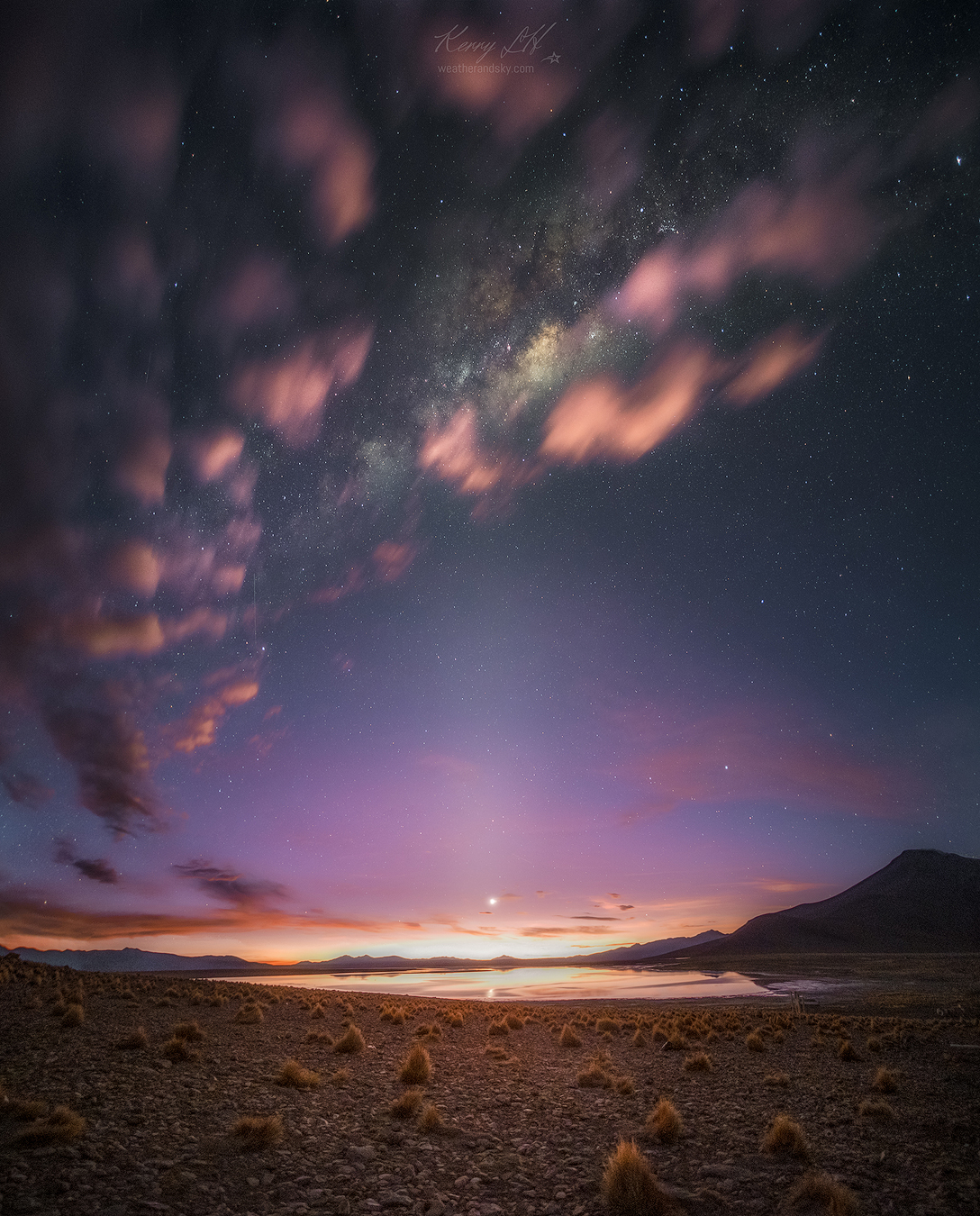
My friend Kerry recently captured this gorgeous view of morning clouds, the Milky Way and the Zodiacal Light extending upwards past bright Venus. Her stitched together panorama from the Bolivia High Dessert employed a 15mm fish-eye lens on her Canon R6 camera. For more treats like these, follow Kerry on Instagram and FaceBook https://www.facebook.com/kerryann.hepburn.
Hello, Late-March Stargazers!
Here are your Astronomy Skylights for the week of March 24th, 2024 by Chris Vaughan. Feel free to pass this along to your friends and send me your comments, questions, and suggested topics. You can also follow me on Twitter as @astrogeoguy! Unless otherwise noted, all times are expressed in Eastern Time. To subscribe to these emails please click this MailChimp link.
If you’d like me to bring my Digital Starlab portable inflatable planetarium to your school or other daytime or evening event in Simcoe County, or deliver a session online anywhere, contact me through AstroGeo.ca, and we’ll tour the Universe, or the Earth’s interior, together! My book with John A. Read entitled 110 Things to See With a Telescope is a guide to viewing the deep sky objects in the Messier List – for both beginners and seasoned astronomers. DM me to order a signed copy!
When the moon reaches full on Sunday night it will dip into Earth’s shadow, producing a weak penumbral eclipse. That full moon also controls when Easter lands. Bright Jupiter will continue to dominate in early evening, joined by Mercury shining at its best for 2024 at mid-northern latitudes. I also update the path of Comet Pons-Brooks. Read on for your Skylights!
The Moon
Over the course of this week, Earth’s natural night-light will gradually leave the evening sky and move into morning – allowing us to return to after-dinner stargazing. But before the moon does that, it will put on a bit of a show.
Since the moon will reach its full phase on Monday, March 25 at 3:00 am EDT, 12:00 am PDT, or 07:00 Greenwich Mean Time, the moon will appear full when it rises at sunset tonight (Sunday) in the Americas. The March full moon, known as the Worm Moon, Crow Moon, Sap Moon or Lenten Moon, always shines in or near the stars of Leo (the Lion) or Virgo (the Maiden). This full moon will also be the Paschal moon. The name “paschal” is derived from “Pascha”, a transliteration of the Aramaic word meaning Passover. The Paschal moon controls when Easter and Passover are observed. The moveable feast of Easter always falls on the Sunday following the Paschal full moon. This year that will be next Sunday, March 31. I’ll share more about Easter and astronomy next week.
The indigenous Ojibwe people of the Great Lakes region call this full moon Ziissbaakdoke-giizis “Sugar Moon” or Onaabani-giizis, the “Hard Crust on the Snow Moon”. For them it signifies a time to balance their lives and to celebrate the new year. The Cree of North America call it Mikisiwipisim, the “the Eagle Moon” – the month when the eagle returns. The Cherokee call it Anvyi, the “Windy Moon”, when the planting cycle begins anew.
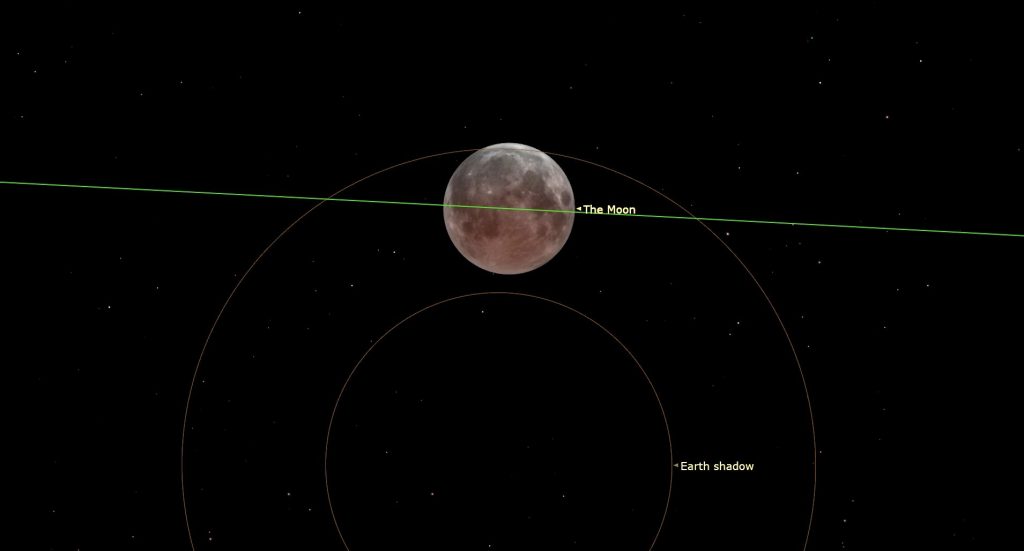
Saturday night’s full moon will pass through the northern portion of the Earth’s penumbral shadow, slightly darkening the moon in a penumbral lunar eclipse visible across the Americas. The lower (southern) rim of the full moon will start to dip into the shadow at 12:53 am EDT (04:53 GMT) on Sunday morning. At maximum eclipse at 3:14 am EDT (07:14 GMT) 96% of the moon will be immersed. The moon will slide fully clear of the penumbra at 5:33 am EDT (09:33 GMT). A detectable darkening of the moon is only expected to be apparent between 2:30 and 4 am EDT (06:30 to 08:00 GMT). I’m not setting the alarm for this one! Since eclipses occur in pairs, this lunar eclipse will be followed two weeks later by the total solar eclipse on April 8.
Last week, I mentioned some interesting aspects of full moons and posted some labeled images of the moon here to guide your viewing on the next few nights. There’s also a very nice moon map here.
For the rest of the week the moon will wane in phase and rise an hour later each night – allowing it to linger ever-longer into the early morning daytime sky. The moon will also be traversing the lengthy constellation of Virgo (the Maiden) until Tuesday, then it will pass into next-door Libra (the Scales) on Wednesday-Thursday. Night-owls on Friday and/or early risers on Saturday morning will see the waning gibbous moon shining in the clutches of Scorpius’ claws. The moon will be positioned to the upper right of Scorpius’ brightest star, reddish Antares. As the hours pass, the moon will slide closer to the star and the diurnal rotation of the sky will lift the star to the moon’s left. By dawn the pair will shine low in the southwestern sky. Skywatchers in more westerly time zones will see the moon even closer to Antares and observers in northeastern Melanesia and most of Polynesia can watch the moon cross in front of (or occult) Antares around 5 am in their time zone.

The moon will end this week near the stars that mark the eastern foot of Ophiuchus (the Serpent-Bearer). That large, but lesser-known constellation sits above the glittering stars of Scorpius in the evening sky every summer. By rights, Ophiuchus should have been the 13th Zodiac constellation because in mid-December the sun passes through the same portion of him that Sunday’s moon will shine in.
Evening Zodiacal Light
If you live in a location where the sky is free of light pollution, you might be able to spot the zodiacal light during the two weeks that precede the new moon on April 8. Starting at mid-week, after the evening twilight has faded, you’ll have about half an hour to check the western sky for a broad wedge of faint light extending upwards from the horizon and centered on the ecliptic around the planet Jupiter. That glow is sunlight scattered from countless small particles of material that populate the plane of our solar system. Don’t confuse it with the brighter Milky Way, which extends upwards from the northwestern horizon in evening at this time of year.
Comet Pons-Brooks
I’ve been updating everyone about a periodic comet named 12P/Pons-Brooks that is visible in the northwestern sky in early evening. The comet has so-far reached about magnitude 5, which is within reach of a small backyard telescope or good binoculars under dark skies. Unfortunately, the bright moon will hamper our comet views until mid-week. The comet should continue to grow brighter as it draws closer to the sun and warms further. You may have heard this comet referred to as the “Devil Comet”, a silly clickbait name that is a leftover from last fall when the comet sprouted two fonts of gas that made it resemble a horned head or the Millennium Falcon. It no longer looks that way.
For observers in mid-northern latitudes on Earth, the comet will be descending the western sky after dusk every night. The best combination of sky darkness and the comet’s height will be around 9 pm in your local time zone. Visually, expect to see a faint, fuzzy smudge that may look greenish in photographs and larger telescopes. Its faint tail, best seen in binoculars and long exposure photos, will extend upwards. The comet will drop below the treetops by about 9:30 pm, so look earlier than later.

This week, Comet Pons-Brooks will continue to travel in the direction of Jupiter – from lower right-to-upper left in the sky. Tonight (Sunday) it will be positioned two fist diameters to the lower right of Jupiter and several finger widths below the medium-bright star named Mothallah and Caput Trianguli. The comet will shift one finger’s width closer to Jupiter each night. The bright star named Hamal in Aries (the Ram) will shine between Jupiter and the comet until Saturday, when the comet will be parked just to the right of that star – and therefore extremely easy to find! On Sunday night, the comet will shift to Hamal’s left. In fact, the comet and Hamal will appear together in a low power telescope from Friday to next Sunday. Let me know if you see it!

The Planet Mercury
If you live at a mid-northern latitude, this will be the best week of the year to see the elusive planet Mercury in the evening. Here are some interesting tidbits about the innermost planet.
The earliest known record of Mercury was as “the jumping planet” inscribed on the Babylonian MUL.APIN tablets inscribed around 1,000 BCE. It was also mentioned in works by Ptolemy (100-170 CE). The Greeks named the rapidly moving planet for Hermes, the fleet-footed herald of the gods. The Romans used their own version of the same deity Mercurius. The ancient Chinese called it the Hour Star, though later it became ShuiXing “the Water Star”, one of the five elements. The Maya may have envisioned Mercury as an owl that carried messages from the underworld – perhaps because it frequently climbed the sky and then dove down below the horizon.

Once Galileo began to use a telescope/spyglass as a tool for astronomy in 1610, Mercury’s varying phases became apparent, confirming that it was a sphere that orbited the sun. Moreover, on November 7, 1631, the French natural philosopher Pierre Gassendi observed a transit of Mercury’s small, black dot across the disk of the sun. The event had been predicted by Johannes Kepler in 1630. On May 3, 1661 Polish astronomer Johannes Hevelius observed another transit of Mercury and published his study. The next transit of Mercury will be visible in Europe and Africa on November 13, 2032.
In the 19th and early 20th century, various astronomers attempted to map mercury’s surface features. Eugenios Antoniadi published a book in 1934 that included both maps and his own notes from (dangerous) observations he made in daytime while Mercury was high in the sky beside the sun. Nowadays many of the planet’s markings or albedo features take their names from Antoniadi’s map, which you can view at https://planetarymapping.elte.hu/antoniadis-map-of-mercury-1934/.
In 2000, the “lucky imaging technique”, where the best frames of a movie of Mercury were extracted, was carried out using the 1.5 metre Hale telescope at Mount Wilson Observatory in California. That provided the first views that resolved surface features on the portions of Mercury that had not already been photographed when the Mariner 10 mission flew past Mercury in the 1970’s. Most of the planet has also been mapped by the Arecibo radar telescope. That telescope’s 5 km resolution discovered deposits of what may be water ice in craters at Mercury’s poles. Unlike Earth’s 23.5-degree tilt, Mercury has almost no axial tilt, leaving the craters at the poles in permanent shadow.
Mercury is the smallest planet in the solar system. It is smaller than both Jupiter’s moon Ganymede and Saturn’s moon Titan, but Mercury’s bulk density of 5.43 g/cm3, almost identical to Earth, makes it more massive than those icy moons. The 70% of Mercury that is metallic includes a large, iron-rich core. The remaining 30% is silicate material in the planet’s crust and mantle. Mercury’s oversized core may have arisen due to the outer, lighter crustal silicates being stripped away after Mercury was formed – either through a large impact or erosion from the solar wind. Or, there was a lack of lighter materials when the planet formed.

Mercury’s surface resembles the moon’s, but it doesn’t have the dark lunar maria we are used to seeing. There is no plate tectonics on Mercury, but there may be volcanic activity due to tidal forces arising from its varying distance from the sun. Mercury has an extreme orbital eccentricity of 0.21, so its distance from the sun ranges from 46 to 69.8 million km (or 0.31 to 0.47 Astronomical Units) Those extremes yield 17 times stronger tidal forces than Earth’s moon and a highly variable orbital speed. At perihelion Mercury moves 50% faster than it does at aphelion!
Mercury experiences one solar day every two Mercurian years (in contrast to Earth’s 365 solar days in one Earth year). During Mercury’s perihelion, the sun seems to hang in the same place in the sky for 2-3 weeks, preferentially heating that spot on the planet’s equator. On alternate years, that spot is transferred to the opposite side of the planet. Meanwhile, there are two sites at 90° to those hot spots that are anomalously cooler because the sun crosses the sky faster and is farthest away (aphelion).
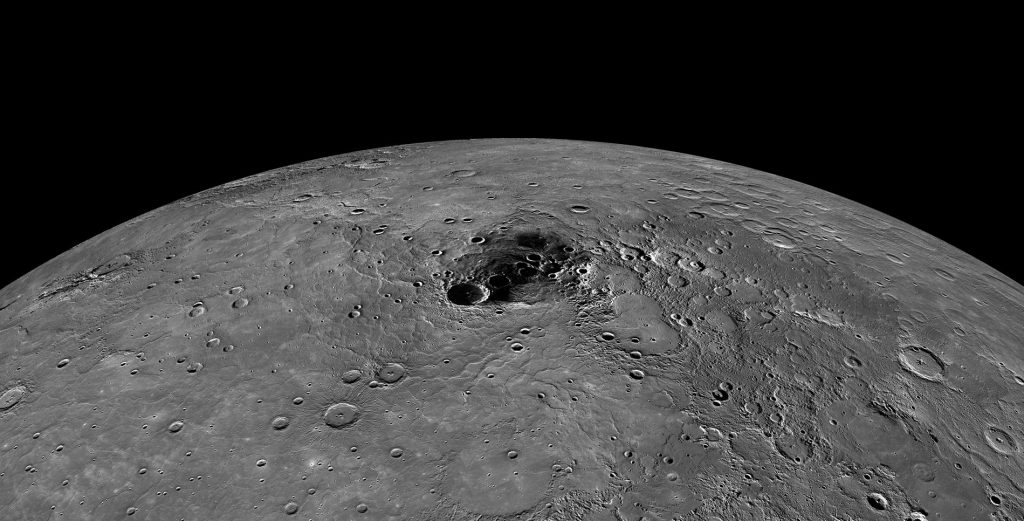
We have created coordinate systems for each of the solar system planets so that we can specify where things are. That job is made easier if they have visible landmarks near their equator. Since the selected 0° W longitude of Mercury (one of the hot spots) was in darkness when Mariner 10 flew by, only 703 km above the surface, on March 29, 1974, no visible crater could be assigned to straddle the prime meridian. Instead, a crater named Hun Kal that was photographed was chosen to define the 20° W meridian and the other longitudes were extrapolated from there.
Mercury orbits the sun every 88 days, its sidereal period, and it never ventures far from the sun –alternating its appearance between the western sky after sunset and the eastern sky before sunrise. Mercury is easiest to see when it is farthest from the sun. At those elongations, it can rise early enough or set late enough to shine in a dark sky. The rest of the time, it is swimming in twilight, making it harder to see. Mercury can never stretch more than 28 degrees from the sun. Mercury’s orbital inclination of 7° causes it to wander well north and south of the ecliptic. Since the ecliptic can be canted over at times, Mercury is frequently below it and stuck just above the horizon – even if its angle from the sun is large. We call those poor apparitions. On the same day, the ecliptic slope can be much different for mid-northern and mid-southern latitude observers, so your location controls the quality of the apparition.
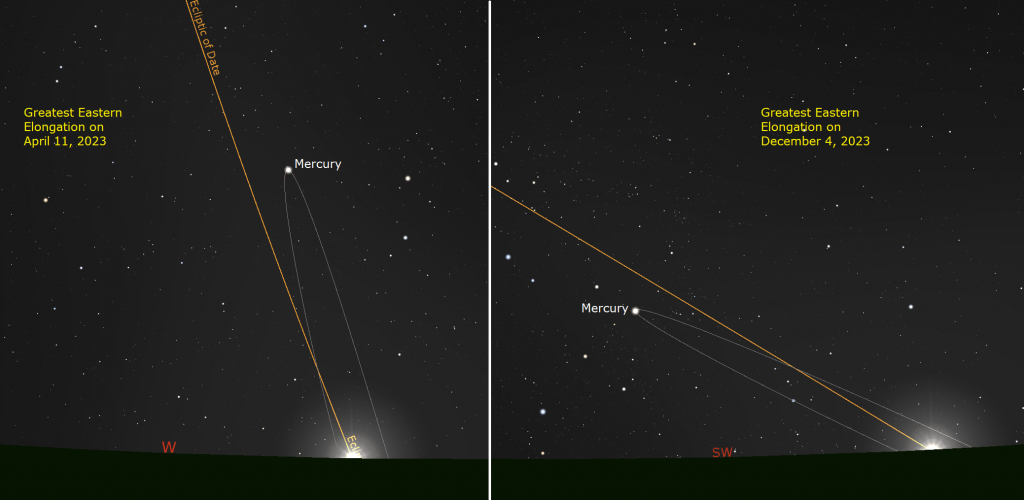
On average, Mercury is the closest planet to Earth. (Our next-door neighbour Venus gets closer to us, but also can be much farther away for much of the time.) Since we view Mercury from the moving platform of Earth, Mercury’s appearance intervals alternate between 73 days and 45 days, and its illuminated phase repeats at the sum of those two, or ~116 days, the synodic period. Its apparent brightness varies dramatically, from a brilliant magnitude -1.9 at superior conjunction to a 1,300 times fainter magnitude +5.9 at inferior conjunction.
Through a telescope, as Galileo discovered, Mercury varies in both in size and in illuminated phase. It will appear as an almost perfectly full, 4.5 arc-seconds-wide disk just before and after superior conjunction (on the far side of the sun from Earth), and as a razor-thin crescent on a 13 arc-seconds globe just before and after inferior conjunction (between Earth and the sun). For eye safety you must ensure that the sun is completely hidden below the horizon when you view Mercury with optical aids. Unfortunately, telescope views are rarely crisp because we are viewing the low in the sky planet through a lot of Earth’s turbulent atmosphere.
The Planets
Tonight (Sunday, March 24), Mercury will reach its widest separation of 18.7 degrees east of the sun for its current apparition. With the speedy planet sitting above a nearly vertical evening ecliptic, this will be Northern Hemisphere observers’ best appearance of the planet in 2024. The optimal viewing times at mid-northern latitudes will fall between 7:30 and 8:30 pm local time. Look for the planet above the western horizon, about two fist diameters below and a little to the right (or 22 degrees to the celestial ESE) of Jupiter. Viewed in a telescope the planet will exhibit a waning phase that rapidly transforms from half-illuminated to a crescent as the week unfolds. Mercury will also drop a bit lower each night as it heads to its next meeting with the sun.

Jupiter itself will pop into view about halfway up the darkening western sky. Though we’ll lose sight of the brilliant king of planets in a few weeks, Jupiter is still showing well in any telescope, especially if you view it early-on, while it’s higher in the sky. The reasonably good views of Jupiter will last until about 9 pm local time. Then the planet will set in the west around 11 pm. In a dark sky, the stars of Aries (the Ram) will appear to Jupiter’s right, the bright stars of the winter constellations will sparkle off to its upper left (or celestial southeast), and the pretty Pleiades cluster will glitter 1.4 fist widths above Jupiter.
Any decent pair of binoculars can show you Jupiter’s four largest Galilean moons lined up beside the planet. Named Io, Europa, Ganymede, and Callisto in order of their orbital distance from Jupiter, those moons complete orbits of the planet every 1.7, 3.6, 7.2, and 16.7 days, respectively. If you see fewer than four moons, then one or more of them is crossing in front of or behind Jupiter, or hiding in Jupiter’s dark shadow – or two of the moons are very close together or occulting one another. All four moons will huddle to one side of Jupiter tonight (Sunday).
A small telescope will reveal Jupiter’s dark belts and light zones, which are aligned parallel to its equator. With Jupiter is descending in the west these days, those stripes are tilted upright. With a better grade of optics, Jupiter’s Great Red Spot, a cyclonic storm that has raged for hundreds of years, is visible for several hours when it crosses the planet every 2nd or 3rd night. GRS appearances are fewer when the planet is only visible for a few hours each night. For observers in the Americas, the GRS will cross Jupiter’s disk in mid-evening Eastern Time on Monday, Thursday, and Saturday. The spot has been rather a pale pink in colour for some time now. If you have any coloured filters or nebula filters for your telescope, try enhancing the spot with them.
From time to time, observers with good quality telescopes can watch the small, round, black shadows of the Galilean moons as they traverse Jupiter’s disk. On Monday evening, March 25, the large shadow of Ganymede will cross near Jupiter’s southern pole from 6:45 to 8:18 pm (or 22:45 to 0:18 GMT).
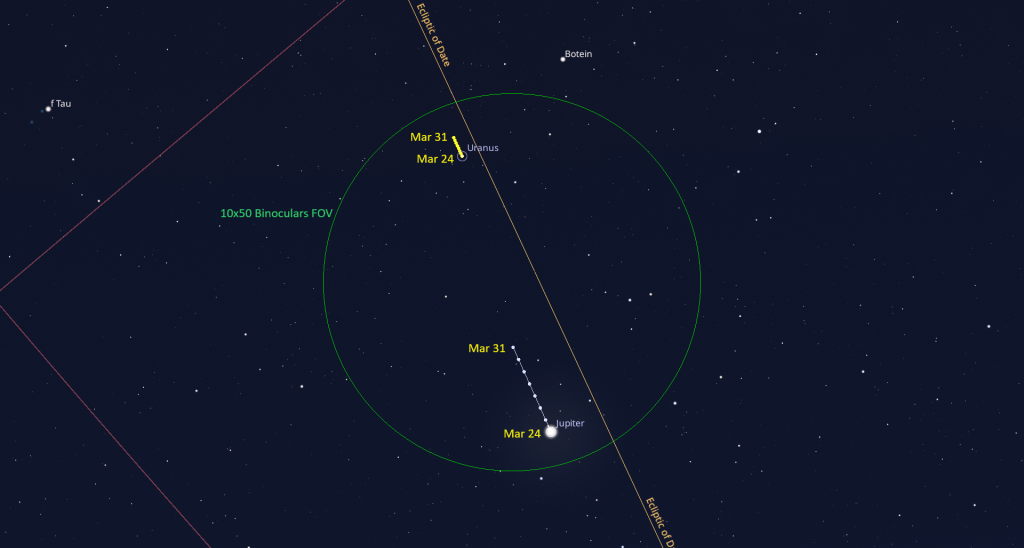
Uranus‘ blue-green speck is trailing about 25 minutes behind Jupiter on the ecliptic. Once the bright moon leaves the scene later this week the magnitude 5.8 planet will be quite easy to see in binoculars and backyard telescopes until about 9:30 pm. Look for Uranus a few finger widths to Jupiter’s upper left (or celestial east). That is close enough for them to share the view in binoculars – with Uranus at the top and Jupiter at the bottom. Uranus will also be positioned less than two finger widths to the lower left of a medium-bright star named Botein (or δ Arietis). The bright Pleiades star cluster will sparkle a bit more than a fist’s width above Uranus (or 11° to its celestial northeast). Since Jupiter is closer to the sun than Uranus, its faster motion will carry it steadily closer to Uranus every night until they kiss in twilight on April 20. This week their separation will shrink from 4.6° to 3.5°.
Mars, Venus, and Saturn will all rise in the east shortly before the sun – but the severely tilted morning ecliptic will keep them low in a brightening sky, making fainter Saturn hard to see. Observers living closer to the tropics, where the ecliptic will stand upright, will have a much easier view.
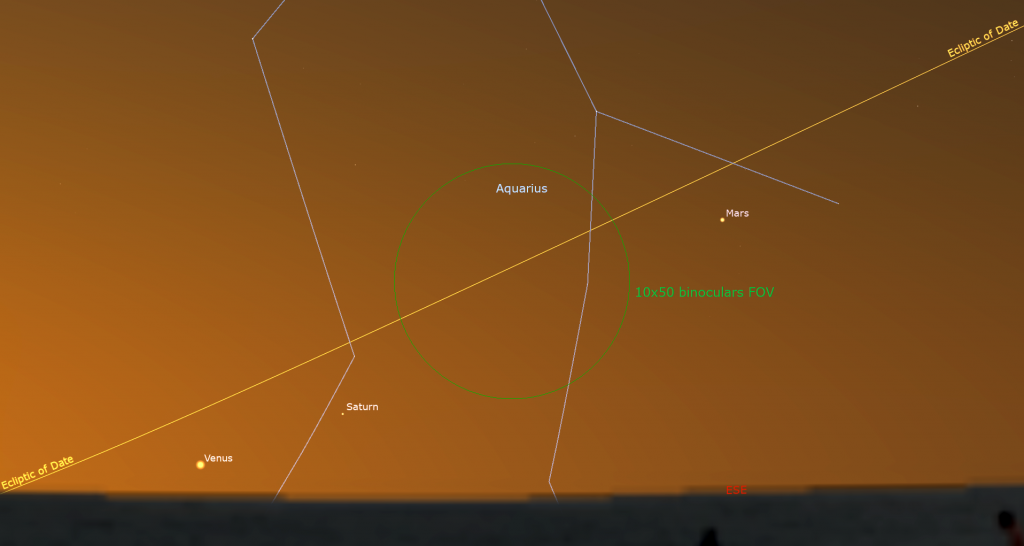
Venus is swinging closer to the sun every morning, causing the brilliant planet to shift down and to the left compared to any nearly trees or buildings near it. Venus will meet the sun at solar conjunction in early June. Mars and Saturn are increasing their angle from the morning sun, eventually allowing them rise with the stars this spring. Saturn will be located to Venus’ upper right. Medium-bright, magnitude 1.8 Mars, in Aquarius (the Water-Bearer), will shine to the upper right of Venus and Saturn every morning. At mid-northern latitudes Mars will rise at about 6 am local time, but you may need to walk around to position the planet between trees or buildings.
Public Astronomy-Themed Events
Every Monday evening, York University’s Allan I. Carswell Observatory runs an online star party – broadcasting views from four telescopes/cameras, answering viewer questions, and taking requests! Details are here. They host in-person viewing on the first clear Wednesday night each month. Other Wednesdays they stream views online via the observatory YouTube channel. Details are here.
Keep your eyes on the skies! I love getting questions and requests. Send me some!